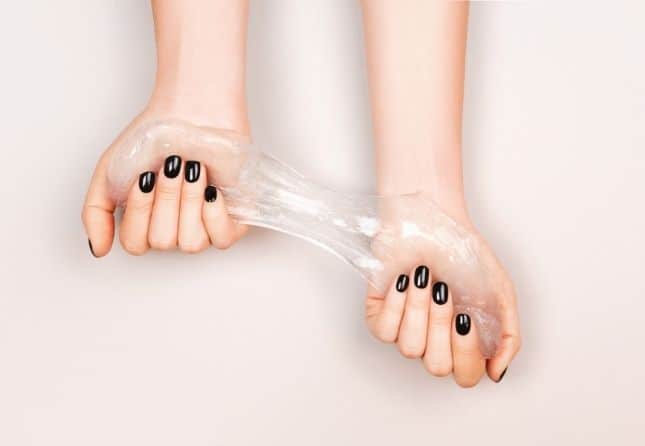Home > Hormones > Hormone issues & symptoms > Estrogen, Progesterone, and mood swings


Have you noticed that you get mood swings in the second half of your cycle? Let’s talk Estrogen, Progesterone, and mood swings. Or how changing hormone levels can have a huge impact on your emotional state.
During the second half of the cycle, after Ovulation, known as the luteal phase, the predominant hormone becomes Progesterone. It’s produced by the corpus luteum, which is the group of cells left over after an egg is released from your ovary during ovulation. The diagram below shows what the different hormone levels are doing during the Menstrual cycle.

Our hormones and our moods are very interlinked. Many people find that their moods change quite a lot throughout their Menstrual cycle.
Estrogen usually acts to improve our mood. It peaks just before Ovulation so a lot of people notice that they feel pretty good around this time of their cycle. Estrogen also increases serotonin which is one of the hormones that makes us feel happy.
It also impacts other “happy” chemicals in the brain like endorphins, making their levels rise. These are also produced when we exercise. You might have heard of them in that context, or in Legally Blonde!
While Estrogen has a largely positive effect on our mood, the effect of Progesterone is slightly less predictable. In some people, it has a depressant effect. There isn’t a massive amount of research on Progesterone and mood – don’t get us started on how we need to research these things better! Progesterone seems to make the part of our brain that reacts to danger, or stress, more reactive.
This part of the brain is called the amygdala, and a more responsive amygdala can mean more feelings of anxiety or stress. There is also some evidence that Progesterone might have a similar effect on the brain as alcohol and sleeping pills. This can depress our mood.
As you can see in the chart above, after Ovulation Progesterone becomes the dominant hormone. Estrogen still rises in the Luteal phase but less than Progesterone.
The lower levels of Estrogen mean less of the “happy” effects of this hormone. This can mean that some of us experience mood swings or lower moods at this time. That becomes especially apparent just before our periods, thanks to PMS. This is because the levels of both Estrogen and Progesterone drop quite quickly at that point.
The higher levels of Progesterone during the Luteal phase might also act to depress your mood, as we talked about before.
Everyone is different, so the interaction between Estrogen and mood is different for everyone. There’s also a huge range of “normal” Estrogen levels, so everyone has different amounts of all the hormones. The general trend of change is similar in everyone with a menstrual cycle, but the actual levels and how they make us feel are different for everyone.
We still don’t quite understand all the intricacies of Estrogen’s effect on our moods. You would expect that if Estrogen improves our mood, then we would feel lower after Menopause when we have less of it. This, though, is not the case for a lot of people. In fact, many notice that their moods improve Postmenopause.
This might be because the lack of hormone fluctuations means that we see fewer mood swings following Menopause. Medicine doesn’t quite understand this yet, we quite understand this yet, but it’s even more evidence that we are all different. And that both Menstrual health and Menopause need to be researched better!
If you’re finding that your mood is causing you trouble during the luteal phase or before your period then there are some things that can help.
The American College of Obstetricians and Gynaecologists suggests that stabilizing blood sugar levels with smaller, frequent meals can help with PMS symptoms. Trying to include more complex carbs, like brown rice, grains, and lentils to your diet instead of white bread/rice/pasta can also be helpful.
Calcium-rich foods like green vegetables or mild products can help with mood swings, as can magnesium supplements. Trying to reduce things like alcohol, and caffeine, alongside refined sugar and salt can also help.
If you’re really struggling with your mood, it’s worth talking to a trusted healthcare professional. They will be able to refer you to a psychological support service or prescribe medication to help, if that is something you want to try.
Disclaimer: This website does not provide medical advice. The information, including but not limited to, text, graphics, images, and other material contained on this website is for informational purposes only. No material on this site is intended to be a substitute for professional medical advice, diagnosis, or treatment. Always seek the advice of your physician or other qualified health care provider with any questions you may have regarding a medical condition or treatment and before undertaking a new health care regimen, and never disregard professional medical advice or delay in seeking it because of something you have read on this website.

-


Dr Singh is the Medical Director of the Indiana Sleep Center. His research and clinical practice focuses on the myriad of sleep.

What vaginal discharge colors mean for your health Understanding vaginal discharge colors and meaning is essential for every woman at every stage of life. While some colored discharge may indicate infections, others are normal. White and clear The first discharge

Understanding perimenopause and menopause When talking about perimenopause versus menopause, it’s easy to confuse these two stages. Perimenopause is the transitional period when you move away from your peak fertility and your ovaries gradually stop releasing eggs. In turn, menstruation

Understanding perimenopause and its symptoms When it comes to aging, many women know about menopause but are surprised to learn about the transitional stage leading up to it, called perimenopause. There are three stages of perimenopause: early, late, and menopause,
| Cookie | Duration | Description |
|---|---|---|
| cookielawinfo-checkbox-analytics | 11 months | This cookie is set by GDPR Cookie Consent plugin. The cookie is used to store the user consent for the cookies in the category "Analytics". |
| cookielawinfo-checkbox-functional | 11 months | The cookie is set by GDPR cookie consent to record the user consent for the cookies in the category "Functional". |
| cookielawinfo-checkbox-necessary | 11 months | This cookie is set by GDPR Cookie Consent plugin. The cookies is used to store the user consent for the cookies in the category "Necessary". |
| cookielawinfo-checkbox-others | 11 months | This cookie is set by GDPR Cookie Consent plugin. The cookie is used to store the user consent for the cookies in the category "Other. |
| cookielawinfo-checkbox-performance | 11 months | This cookie is set by GDPR Cookie Consent plugin. The cookie is used to store the user consent for the cookies in the category "Performance". |
| viewed_cookie_policy | 11 months | The cookie is set by the GDPR Cookie Consent plugin and is used to store whether or not user has consented to the use of cookies. It does not store any personal data. |
